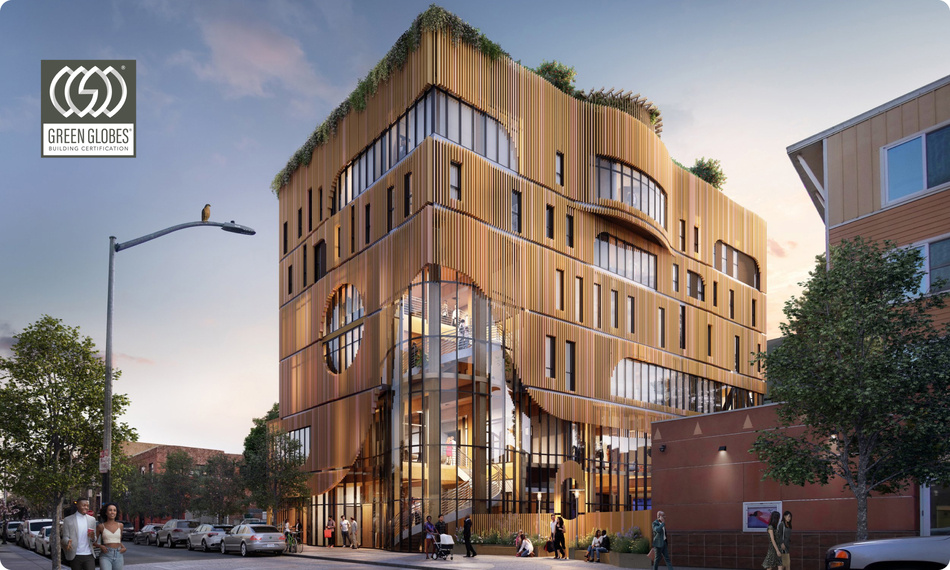How performing a whole building life-cycle assessment with One Click LCA helped The Village SF reduce embodied carbon by 25-30% and achieve sustainability goals, including Green Globes certification.

The Village SF is a six-story mass timber construction project in the heart of San Francisco’s Mission District, housing social services, treatment and recovery programs, and supportive housing for the local urban Indian community. Innovation and sustainability were prioritized to meet rigorous certification standards.
Where design meets sustainability: Integrating beauty, community, and carbon reduction through life-cycle assessment
The purposeful design of The Village SF considers impact and incorporates a nature based relationship that connects the community with the natural environment in an urban setting. Sustainability features include construction materials that sequester carbon, namely, mass timber framing. The Type IV-C mass timber structure will be left exposed on the interior to reinforce the owners’ commitment to nontoxic natural healing surfaces. A “breathing” skin of operable windows and a vertical terracotta lattice will modulate airflow and sunlight. The project was chosen as Green Building Initiative’s (GBI) 2024 ACCESS recipient, an annual program which awards complimentary Green Globes assessment and certification to a project that benefits its local community.
GBI’s Green Globes certification is a science-and consensus-based program that evaluates the sustainability, health and wellness, and resilience of all types of commercial and multifamily real estate. The system emphasizes education and flexibility, offering rigorous yet adaptable pathways to meet the unique needs of each building. GBI offers certification programs for buildings at any point in their life cycle — under new construction, existing buildings, core & shell or sustainable interiors. Green Globes provides a transparent and collaborative assessment process that includes review from a third-party assessor, a site assessment, and personalized recommendations for improvement to improve performance.
.jpg?width=929&height=312&name=Case%20study%20Green%20Globes%20(2).jpg)
Using whole building life-cycle assessment to achieve quantifiable impact reductions
The project team conducted a structural whole building life-cycle assessment (wbLCA), a scientific method for evaluating the environmental footprint of different building materials over their entire life cycle, from extraction to disposal.
Through this assessment, the project team compared the use of mass timber to traditional materials such as reinforced concrete and steel, ensuring that all options were analyzed for their carbon footprint, resource use, and overall sustainability. This case study explores how The Village SF successfully leveraged data from One Click LCA to inform material choices, optimize structural design, and achieve credit towards Green Globes for New Construction certification.
LCA software: Decarbonize and achieve certifications with automated life-cycle assessments
Meeting the demand for lower-carbon construction without compromising performance
The Village SF was designed with a clear goal: to minimize embodied carbon while maintaining the structural integrity and performance expected of a modern building. Achieving this balance was critical, as according to the WGBC, buildings are currently responsible for 39% of global energy related carbon emissions.
The project team faced several critical priorities:
Quantifying the environmental trade-offs between materials.
While mass timber is known for its ability to store carbon, its full environmental impact had to be assessed in comparison to steel and concrete to ensure an evidence-based decision.
Meeting strict regulatory requirements.
The structural system needed to comply with fire safety, acoustic performance, and durability standards, all of which influence material selection.
Providing verifiable data for certification.
The certification process encouraged a science-backed evaluation of how material choices would reduce greenhouse gas emissions and other environmental impacts over the building’s life-cycle.
To address these challenges, the team needed a data-driven approach that would provide clear, comparative insights into the environmental footprint of different construction materials. This required a wbLCA that covered all major structural components, from gravity and lateral supports to foundations and substructure.
.jpg?width=929&height=312&name=Case%20study%20Green%20Globes%20(3).jpg)
Using wbLCA to compare mass timber, steel, and concrete
The project team used One Click LCA to conduct a structural wbLCA to analyze the environmental impact of mass timber against conventional alternatives. The assessment included the full life-cycle of materials, from raw material extraction and production to construction, operation, and end-of-life disposal or reuse.
The methodology followed Green Globes and ISO-compliant standards, ensuring transparency and comparability. Three key structural systems were evaluated:
Mass timber: This system leveraged engineered wood products such as cross-laminated timber (CLT) to reduce embodied carbon while maintaining structural integrity.
Reinforced concrete: While widely used for its strength and durability, concrete has a high carbon footprint due to cement production, which is responsible for approximately 8% of global CO2 emissions.
Steel framing with composite decking: Steel is durable and widely recyclable, but its production is energy-intensive, requiring large amounts of fossil fuel-derived energy.
To ensure an accurate comparison, the team maintained functional equivalence across all three scenarios, keeping variables such as building size, height, and occupancy consistent. The assessment also incorporated key environmental impact categories, including global warming potential (GWP), fossil fuel depletion, and other indicators required for certification.
Key findings: Mass timber reduces embodied carbon and improves life-cycle performance
25-30%
global warming potential reduction
The results of the wbLCA provided clear evidence that mass timber significantly reduced the environmental footprint of The Village SF’s design compared to alternative structural materials. The assessment revealed several key insights:
Lower embodied carbon
The mass timber design achieved a 25–30% reduction in global warming potential (GWP) compared to reinforced concrete and steel alternatives. This reduction was primarily due to the carbon sequestration properties of wood, which stores atmospheric CO₂ throughout its lifespan.
Optimized foundation design
Because mass timber is lighter than concrete and steel, the required foundation size was reduced, leading to additional savings in embodied emissions.
Improved end-of-life performance
Unlike concrete, which is energy-intensive to recycle, and steel, which requires high-temperature reprocessing, mass timber components have greater potential for reuse or recycling, further improving sustainability metrics.
These findings support the Green Globes process by achieving credit towards certification and providing verifiable data on the building’s environmental performance. The results also helped validate mass timber as a viable structural solution for future low-carbon buildings.
How wbLCA supports certification and informed decision making
By using wbLCA to assess material choices, The Village SF not only made significant progress towards Green Globes certification but also gained valuable insights for future projects. This case study demonstrates that:
- Mass timber is a proven strategy for reducing embodied carbon: The findings confirm that engineered wood products can significantly lower a building’s life-cycle emissions while meeting performance standards.
- Life-cycle assessment is essential for evidence-based sustainability decisions: Without wbLCA, it would have been difficult to quantify the environmental benefits of mass timber relative to steel and concrete.
- Data aligns with sustainable building certification objectives: The wbLCA provided verifiable results that not only contributed credit towards Green Globes certification but also offered valuable data to inform sustainable decisions.
A model for sustainable structural design
The Village SF is a strong example of how life-cycle assessment can drive sustainable decision-making in the built environment. By integrating wbLCA early in the design process, the project team was able to reduce environmental impacts, meet certification requirements, and demonstrate the viability of mass timber for large-scale construction.
As demand for low-carbon buildings continues to grow, the findings from this project reinforce the value of using data-driven methodologies to optimize material choices and achieve measurable sustainability goals.
Architects, designers, and engineers can leverage wbLCA towards Green Globes certifications and reduce carbon emissions with One Click LCA’s automated and easy to use software.
LCA software: Decarbonize and achieve certifications with automated life-cycle assessments
Carbon Experts Newsletter
Industry news & insights — straight to your inbox
Want to learn more?
Muhammad Ali Saleem • Mar 15 2025
Laura Drury • Mar 24 2025
Frida Alfredson • Oct 23 2024
Anna Zahrmann • Feb 12 2025
